This time last year, the drilling moratorium was giving shipbuilders headaches well beyond the Gulf. Those concerns are still around. Despite the announcement that more than 20 million deepwater acres in the western Gulf will be auctioned off to leasing in December, permits for deepwater drilling are not being issued fast enough to satisfy shipyards hungry for workboat orders.
And now there's a new worry. With the bipartisan deficit panel due to report by Nov. 23, the industry faces the prospect of federal budget cuts.
Navy shipbuilding is the most obvious target. But governments spend money on nonmilitary vessels too — this year, for example, the feds picked up 50 percent of the $17.4 million tab for two 28-vehicle ferries in Texas — and programs such as Title XI construction loan guarantees and the Maritime Administration's assistance to small shipyards are vulnerable.
"The budget pressures across government, not just (the Department of Defense), are going to have an impact on the maritime industry," said Joe Carnevale, who specializes in defense for the Shipbuilders Council of America. 'As an example, it will certainly have a dampening effect on the government's ability to invest in offshore energy."
As we report in our review of crew and supply boat yards, drilling rigs have moved out of the Gulf in favor of Central and South America, and that means few orders for vessels to service them. It's significant that one of the largest recent contracts for platform supply vessels, for five boats from Eastern Shipbuilding Group, came from Brazil, not the U.S.
True, some of the larger and better-equipped supply vessels followed the rigs out of the Gulf on three- to five-year overseas contracts, so if the oil companies bring the rigs back, there may be a temporary shortage of the most desirable workboats. But no one expects a boom.
"I think there's going to be building," said Walter Thomassie of Thoma-Sea Marine in Lockport, La. "I'm not saying some of it won't come back. I'm confident it won't all come back."
Meanwhile, yards need new contracts to fill the widening gaps in their order books. And any shipbuilder that can diversify is doing so.
On the Great Lakes, the two shipyards owned by Fincantieri Marine Group, Marinette Marine and Bay Shipbuilding, are building a variety of vessels. Marinette has Littoral Combat Ships, a 261-foot oceanographic research vessel for the University of Alaska Fairbanks, and the latest Oscar Dyson-class fisheries survey vessel for NOAA. Bay Shipbuilding snagged a two-boat order for 303-foot diesel-electric PSVs for Tidewater Marine Services, based in New Orleans.
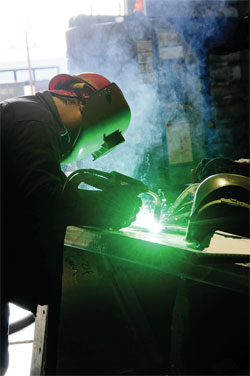 |
|
Brian Gauvin |
|
Welding at Austal USA in Mobile, Ala. Austal is looking to hire skilled workers as its workload increases, and Alabama Industrial Development Training has opened a $12 million Maritime Training Center next door to the shipyard. |
In Pascagoula, Miss., VT Halter Marine is juggling tugs, barges, military contracts and a 692-foot container/ro-ro vessel for the Hawaiian trade — the largest vessel the yard has ever built. Bill Skinner, Halter's CEO, said the yard was happy to see the customer, Pasha Group, return. "We delivered Jean Anne in 2005 and it has proven to be a very good vessel for the type of service that it trades in," he said.
 |
|
Courtesy Baker Hughes |
|
Edison Chouest Offshore’s North American Shipbuilding yard in Larose, La., was also busy, with newbuilds such as this 300-foot well stimulation vessel for Baker Hughes. |
In Louisiana, Bollinger Shipyards had seven Coast Guard patrol boats under construction recently at its Lockport headquarters while its yard in Amelia echoed with the noise of 10,880-hp tugboats being built for Crowley Maritime, sludge ships for New York City and a 55,000-barrel tank barge for Bouchard Transportation. A Bollinger repair yard down the road was also busy. Chris Bollinger, the company's executive vice president for new construction, said he expects the company's mix of business to stay 50-50 between new construction and repair.
At Eastern, based in Panama City, Fla., the order book includes not just PSVs but towboats, offshore supply vessels and a 310-foot multipurpose vessel for Harvey Gulf International. Last year we profiled a fireboat from Eastern; this year the yard accounts for both our Ship of the Year and a 380-passenger vehicle ferry for the Bay of Fundy.
Federal dollars
Shipbuilders have benefited over the last three years from a series of grants under MarAd's program to help small shipyards, particularly for equipment such as cranes. This year, Nichols Brothers Boat Builders of Whidbey Island, Wash., was awarded $519,761 for two mobile cranes, one 25 tons and the other 45. Marinette, mentioned above, collected $604,394 for air compressors and a dust collection system.
Whether the program will survive is in question, and the same is true for MarAd's Title XI ship-construction loan guarantees. U.S. taxpayers are on the hook for about $140 million on the two Hawaiian superferries (MarAd said it received four bids when it put the vessels up for sale this summer, but declined to disclose details). Matt Paxton, president of the Shipbuilders Council of America, is an advocate of Title XI but said he's sensitive to the need to pick candidates judiciously. "We don't want to see any more black eyes," he said.
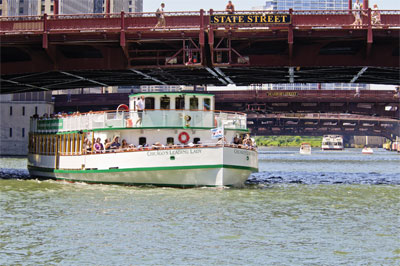 |
|
Brian Gauvin |
|
Seacraft Design drew up plans for this 98-foot excursion vessel to fit under the bridges of Chicago. The builder was Burger Boat. |
Paxton said one casualty of the current political climate may be the Obama administration's ability to invest in alternative energy. "Wind power — could be on the chopping block in these budget talks," he said. Nevertheless, he's optimistic. "Renewable energy is going to happen," he said. "They spent way too much money up in Nantucket Sound for Cape Wind not to take off."
Shipyards in New England are hoping Paxton is right. Gladding-Hearn Shipbuilding of Somerset, Mass., is ready with a 56-foot Incat Crowther catamaran design for servicing wind farms. The boat has seating for 12 and cargo areas fore and aft with a total capacity of 30,864 pounds. Blount Boats, of Warren, R.I., has a similar licensing agreement to build South Boats-designed wind farm cats.
In fact, there is no shortage of wind farm vessel designs. Austal USA's Australian parent is building a 70-foot cat for a British company, and Ad Hoc Marine Designs, another U.K. company, has drawn up plans for a 134-foot SWATH that doubles as a turbine service boat and PSV for the oil industry.
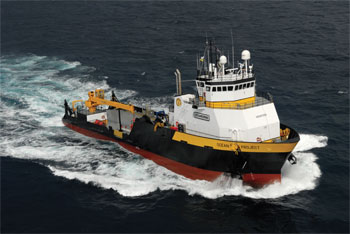 |
|
Courtesy Master Boat Builders |
|
Master Boat Builders delivered a custom-built 195-foot dive support vessel for Houston-based Oceaneering International. |
Another area of growing interest is Arctic navigation and the support vessels that will be needed, especially if a regular maritime highway is established in polar waters. Edison Chouest Offshore, based in Galliano, La., is building eight new deepwater PSVs that can be modified later for Arctic deployment. Chouest is also building a 361-foot Arctic ice class anchor handling vessel for delivery to Shell in Alaska early next year.
As is often the case, Chouest is one of the busiest builders in the industry. This spring, the company put its newbuild backlog at 33 vessels, although some of those were under construction in Brazil and Poland.
It has been several years since U.S. shipyards have built enough passenger vessels to justify a roundup of their own in our annual review, but two boats in particular are worth a mention. Queen of the Mississippi is a 150-passenger vessel for American Cruise Lines powered by two CAT C32s working z-drives (the boat also has a paddlewheel). It was built in two sections by Chesapeake Shipbuilding of Salisbury, Md. Chicago's First Lady, a 98-foot excursion boat designed by Seacraft Design of Sturgeon Bay, Wis., and built by Burger Boat in Manitowoc, Wis., has limited air draft to fit under the Windy City's bridges.
Blount Boats is also building a 300-passenger excursion vessel for Chicago for a repeat customer, Wendella Sightseeing. The designer is another Sturgeon Bay firm, Timothy Graul Marine Design.
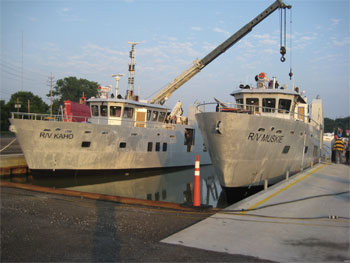 |
|
Courtesy U.S. Geological Survey |
|
These two boats for the U.S. Geological Survey are Great Lakes Shipyard’s first vessels to be built entirely of aluminum. |
As for product carriers, General Dynamics Nassco in San Diego delivered the last in a series of five 49,000-dwt vessels for American Petroleum Tankers, and Aker Philadelphia Shipyard handed over the last of 12 similar ships for Overseas Shipholding Group.
Although the newbuilding occasioned by the double-hulling requirements of OPA 90 has been petering out for some time, this segment of the industry has produced some recent excitement. Helped by financing from the state of Pennsylvania and tax forgiveness from the city of Philadelphia, Aker announced plans to build two more product carriers on spec (it has already cut steel on both), then trumped itself by disclosing a letter of intent to build two Aframax tankers for Exxon Mobil starting in mid-2012 at a reported cost of more than $200 million per vessel.
In the Gulf, BAE Systems Southeast Shipyard in Alabama is finishing up one of the three 42,400-dwt product carriers left high and dry when AHL Shipping filed for bankruptcy a couple of years ago. The original contract was announced at $124 million per ship; the unfinished vessel was reportedly bought for $12.65 million. BAE also announced an agreement with Dutch-based IHC Merwede to build vessels for the offshore industry.
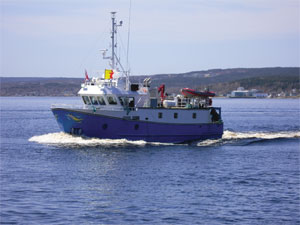 |
|
Courtesy Government of Nunavut |
|
The bow of Nuliajuk, a fisheries research vessel, is decorated with a pair of Sednas — sea goddesses in Inuit mythology. |
For some time, shipbuilders have been hoping to see orders for a new generation of Jones Act container vessels, but the most likely suspect, Charlotte, N.C.-based Horizon Lines, is financially in no position to play along. Interest in short-sea shipping has not led to orders either.
Finally, on a note that may strike fear into professional mariners everywhere, the day of the unmanned vessel has arrived. Zyvex Technologies of Columbus, Ohio, has been touring the country showing off Piranha, a 54-foot planing monohull built of molecularly engineered materials that weighs less than 8,500 pounds empty, carries a 15,000-pound payload and cruises at 25 knots. Zyvex is gearing its sales campaign at the military, but who knows what this means for the future of commercial shipbuilding?
Canadian shipbuilding
By the time you read this, the Canadian government should finally have selected two shipyards to split a $35 billion package for new vessels for the Canadian Navy and Coast Guard.
Under the procurement plan announced more than a year ago, one yard will build combatants, including Arctic patrol ships, and the other will build an oceanographic vessel, fisheries vessels, a polar icebreaker and a joint support ship. Smaller vessels will go to other shipbuilders.
Just as states in the U.S. offer business incentives to builders such as Austal and Edison Chouest, provinces have been aggressively backing their local yards. Nova Scotia has promised to support Irving Shipbuilding in Halifax with infrastructure and training, and British Columbia is standing behind Seaspan Marine Corp. (formerly Washington Marine Group) with $35 million in training and tax credits and $5 million in productivity incentives. BC Ferries said it would kick in an additional $20 million.
STX Canada Marine has been awarded a contract to design the 270-foot ocean research vessel and Robert Allan Ltd. is part of a joint venture designing the smaller fisheries vessels. The design contracts are worth about $2.5 million each. STX has also designed the Arctic offshore patrol ships.
In Halifax, Irving completed a 241-foot PSV, Atlantic Condor, for the Deep Panuke gas field. The vessel has two Bergen 2,560-kW diesels turning controlled-pitch propellers with high-lift flap rudders, with two forward and two aft thrusters. In Lévis, Quebec, the Norwegian company whose three new OSVs have been caught up in the epic financial troubles at what is now Davie Canada expressed its intention to see them completed.
This spring, Exxon Mobil filed a plan with Newfoundland and Labrador to develop the Hebron oil field. And interest in alternative energy is growing. South Korea's Daewoo Shipbuilding & Marine Engineering is opening a plant to manufacture wind turbine towers and blades in Trenton, N.S. — a venture heavily subsidized by the provincial and federal governments — and Irving announced that it is building a turbine for tidal power trials in the Minas Passage in the Bay of Fundy.
Canada has seen a large number of new ferries this year. But perhaps the country's most unusual new vessel is Nuliajuk, a 64-foot steel-hulled fisheries research vessel built by Glovertown Shipyard in Newfoundland for the government of Nunavut's Department of Environment. The cost was $3.2 million.
The bottom is flat and the vessel has a sacrificial keel so it can dry out on mudflats. The bow is decorated with a pair of Sednas — sea goddesses in Inuit mythology — painted by a Nunavut artist, Andrew Qappik.

